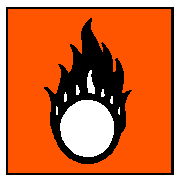International Chemical Safety Cards
| BARIUM PEROXIDE | ICSC: 0381 |
| BARIUM PEROXIDE Barium dioxide Barium superoxide BaO2 Molecular mass: 169.3 CAS # 1304-29-6 RTECS # CR0175000 ICSC # 0381 UN # 1449 EC # 056-001-00-1 |
 |
 |
| TYPES OF HAZARD/ EXPOSURE |
ACUTE HAZARDS/ SYMPTOMS |
PREVENTION | FIRST AID/ FIRE FIGHTING |
| FIRE | Not combustible but
enhances combustion of other substances. |
NO contact with
combustibles, reducing agents and acid(s). |
In case of fire in the
surroundings: all extinguishing agents allowed. |
| EXPLOSION | Risk of fire and explosion
on contact with combustible substances and reducing agents. |
|
|
| EXPOSURE | |
PREVENT DISPERSION OF DUST!
STRICT HYGIENE! |
|
| INHALATION | Burning sensation. Cough.
Laboured breathing. Shortness of breath. Sore throat (see Ingestion). |
Local exhaust or breathing
protection. |
Fresh air, rest.
Half-upright position. Artificial respiration if indicated. Refer for medical attention. |
| SKIN | Redness. Skin burns.
Pain. |
Protective gloves.
Protective clothing. |
First rinse with plenty of
water, then remove contaminated clothes and rinse again. |
| EYES | Redness. Pain. Blurred
vision. |
Safety goggles, or face
shield, or eye protection in combination with breathing protection if powder. |
First rinse with plenty of
water for several minutes (remove contact lenses if easily possible), then take to a
doctor. |
| INGESTION | Sore throat. Abdominal
pain. Vomiting. Diarrhoea. |
Do not eat, drink, or smoke
during work. |
Rinse mouth. Do NOT induce
vomiting. Refer for medical attention. |
| SPILLAGE DISPOSAL | STORAGE | PACKAGING & LABELLING | ||
| Sweep spilled substance into
containers, then remove to safe place. Do NOT absorb in saw-dust or other combustible
absorbents. Do NOT let this chemical enter the environment (extra personal protection: P2
filter respirator for harmful particles). |
Separated from combustible
and reducing substances, food and feedstuffs. Dry. |
Do not transport with food
and feedstuffs. O symbol Xn symbol R: 8-20/22 S: (2-)13-27 UN Hazard Class: 5.1 UN Subsidiary Risks: 6.1 UN Packing Group: II |
||
| SEE IMPORTANT INFORMATION ON BACK | ||||
|
||||